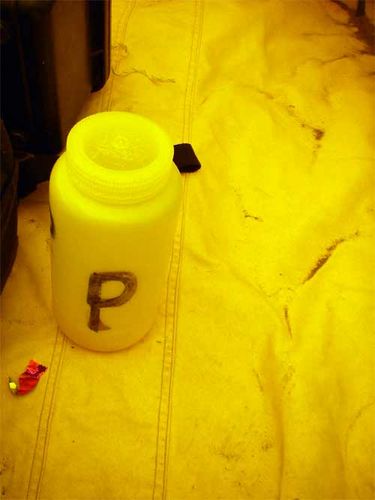When we set up camp in the evening on November 17, it was a dry, sunny, clear day and I thought to myself, the Dry Valleys are not like the rest of Antarctica. The temperature felt like it could be a spring day in the high Sierras of California. Within 24 hours the winds that Beacon Valley is famous for began blowing and within the next couple of days, I would be the coldest I have ever been in my life. I spent the first full day adjusting to camp life and getting used to the "facilities" such as they are. The first thing readers of this journal need to understand is that Beacon Valley is considered a "deep field" camp with no facilities of water. All liquid and solid waste must be separated and hauled out of camp to McMurdo and eventually off Antarctica for disposal. Any female reading this journal knows that separating liquid and solid waste requires great skill and control.
Also, if you continue to read my journal, you cannot be uncomfortable with the topic of peeing. In fact, when, how, where, and how often is a major topic of conversation in Antarctica, and especially in deep field camps. It is not uncommon to have a conversation with a famous scientist, National Geographic photographer, BBC production crew member, or anyone else in Antarctica male or female, while he or she is holding a pee bottle. Seminars are given on the topic of pee and a full session was devoted to peeing at Happy Camper School. Pee bottles are given out at the Berg Field Center where field gear is supplied. You are not allowed on some day trips around McMurdo if you do not have a pee bottle.
I was nervous about bringing up this topic with Dave and the team because it is not a discussion I would have with someone I am intimate with, not to mention total strangers. People here don't give it a second thought. Since I have a private tent, I can collect my pee privately and I tried to time when I emptied the bottle so I did not run into anyone else in the camp. By the third day at camp, I poured my pee bottle into the drum like everyone else without a second thought.
 This is my official government issued Pee Bottle.
This is my official government issued Pee Bottle.
 The white arrow points to the pee drum. Mullins Valley is in the background.
The white arrow points to the pee drum. Mullins Valley is in the background.
Well now for the solid waste part which is not so amusing. The team created a toilet seat cover for what is essentially a bucket lined with plastic. It is simply called "The Box". And yes, we all have to use it no matter how unpleasant we find it. After a few meals with the team, I realize that everyone finds it uncomfortable. It is often a topic of conversation at meal times. As I mentioned earlier, these types of conversations are not considered poor form in Antarctica.
 I think this photo says it all.
I think this photo says it all.
We may not have the comforts of home, but look at the views from our campsite.
 I can see Taylor Glacier from my tent.
I can see Taylor Glacier from my tent.
 Contact between the Devonian Sandstone and 180 million year old volcanics. Notice the polygons at the base.
Contact between the Devonian Sandstone and 180 million year old volcanics. Notice the polygons at the base.
The team members collect drinking water from nearby snow banks when we camp. The water is used for cooking, drinking, and brushing teeth. We do not shower. Based on advice received from previous PolarTREC participants, I brought lots of baby wipes.
 Dave brings in freshwater from a nearby snow bank to boil for hot beverages. Notice the calendar underneath the pot.
Dave brings in freshwater from a nearby snow bank to boil for hot beverages. Notice the calendar underneath the pot.
The only accurate weather report can be obtained from a meteorological station that is installed nearby. When Sean went to check the station and download the data, he discovered the anemometer had blown off in the wind. I am relying on Dave's 20 years of experience in the area to relay the correct wind speed.
Now that you have seen the good, the bad and the ugly of the camping situation, what is the status of the drilling? I understand that the drilling in Mullins Valley was successful in terms of reaching Dave's goal depth of 20 meters. I joined the team at the second drilling location in Beacon Valley. This location is more difficult because of the rock debris that is mixed with the ice. The drilling is going much slower and modifications have to be made to penetrate the subsurface.
It is very windy outside, but tomorrow I will go out with the team to the drilling location.

